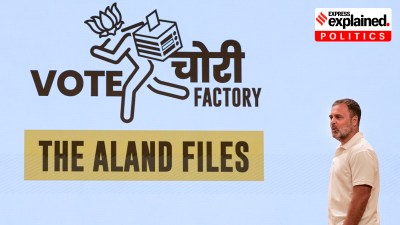Vikas Pathak is deputy associate editor with The Indian Express and writes on national politics. He has over 17 years of experience, and has worked earlier with The Hindustan Times and The Hindu, among other publications. He has covered the national BJP, some key central ministries and Parliament for years, and has covered the 2009 and 2019 Lok Sabha polls and many state assembly polls. He has interviewed many Union ministers and Chief Ministers. Vikas has taught as a full-time faculty member at Asian College of Journalism, Chennai; Symbiosis International University, Pune; Jio Institute, Navi Mumbai; and as a guest professor at Indian Institute of Mass Communication, New Delhi. Vikas has authored a book, Contesting Nationalisms: Hinduism, Secularism and Untouchability in Colonial Punjab (Primus, 2018), which has been widely reviewed by top academic journals and leading newspapers. He did his PhD, M Phil and MA from JNU, New Delhi, was Student of the Year (2005-06) at ACJ and gold medalist from University Rajasthan College in Jaipur in graduation. He has been invited to top academic institutions like JNU, St Stephen’s College, Delhi, and IIT Delhi as a guest speaker/panellist. ... Read More
Amid buzz over BJP mulling a working president to replace Nadda, a look at how its chief is chosen
There has never been a contest for national president’s post in BJP since its formation in 1980, although the party constitution provides for an electoral college for it
 Union Minister JP Nadda speaks in the Lok Sabha during the Monsoon session of Parliament, in New Delhi, Friday, Aug. 2, 2024. (PTI Photo)
Union Minister JP Nadda speaks in the Lok Sabha during the Monsoon session of Parliament, in New Delhi, Friday, Aug. 2, 2024. (PTI Photo) With BJP president J P Nadda having been inducted in the Narendra Modi Cabinet 3.0, decks have been cleared now for the party to have a new chief in accordance with its “one-person, one-post” rule.
Now, there have been increasing talks in the BJP circles that the party may have a working president soon – a break from the earlier perception that Nadda, whose term ended in June, would continue till a new party president is chosen in some months. However, there is no clarity on the issue yet.
The process leading up to the election of the next BJP president will start soon, when the party begins its membership drive this month. Like always, the elections to the party’s local committees will be held first, followed by polls for the mandal committees, district committees, regional committees and state committees. The president elected at each level will nominate his team of office-bearers. Once elections to half the states have been held, the election of the national president takes place as per the BJP’s long-established practice. The new national president then nominates his team of office-bearers.
Significantly, there has never been a contest for the post of the national president in the BJP since its formation in 1980, although the party constitution provides for an electoral college for it. There is always only one candidate who files the nomination for the party chief’s post, who is then elected unopposed.
When the BJP is electorally weak – like in the period after the 2009 Lok Sabha polls – the RSS plays a bigger role in the choice of the party president. This is how Nitin Gadkari was brought to Delhi from Maharashtra as the party chief in 2009, as the RSS wanted him to steady the ship after the party’s Lok Sabha poll tally fell to 116.
However, when the BJP is electorally strong and ruling the Centre – as it has been for the last 10 years – it is the Prime Minister and his few confidants who play a decisive role in determining the candidate for the party president’s post, following which the chosen leader files the nomination and gets elected unopposed.
In other words, the BJP has never witnessed the kind of contest for the president’s post that happened in the Congress between its leaders Mallikarjun Kharge and Shashi Tharoor in 2022 – though such contests have been rare even in the Congress. Before 2022, it was in 2000 that the Congress saw a presidential face-off when Jitendra Prasada took on Sonia Gandhi. The only time when there was a one-day flutter of a possible presidential contest in the BJP was in 2013, when then party leader Yashwant Sinha procured nomination papers before the elections – before choosing not to follow up on the act.
The BJP constitution, though, has a provision for a contest for the top post. It says that if there is more than one candidate after the date of withdrawal of nominations, then polling will be held in all state capitals on the appointed day by polling officers appointed by the all-India returning officer. The sealed ballot boxes will then be brought to Delhi, and the votes counted. The candidate winning the highest number of votes will then be declared elected. However, this has never taken place in the party.
If the BJP indeed appoints a working president, it will be its Parliamentary Board’s decision. “The Parliamentary Board may meet for it, but it is also possible that the top leaders have telephonic conversations with all members of the Board and simply decide who the working president will be. In such a case, the Board may also not physically meet,” said a senior BJP leader on condition of anonymity. Pointing out that there is a lot of functional flexibility in these decisions, the leader added that if there is an urgent need, the Parliamentary Board can also name a full-time president on its own, with the party National Council ratifying the decision within six months.
The BJP’s national president can have two consecutive terms of three years each. This amendment was made in 2012, when the RSS wanted Nitin Gadkari to be the president for the second consecutive term. However, at the last moment, Rajnath Singh was made party president – a post he retained till the party won the 2014 Lok Sabha election. Afterwards, Amit Shah became the BJP chief.
Active members of the BJP are those members who, as per the BJP’s constitution, have been primary members of the party for three years, and deposit a non-refundable amount of Rs 100 to seek the said membership. Any Indian citizen, 18 years of age or above, can become a primary member of the BJP on payment of a prescribed subscription for a period of six years, after which he has to fill the membership form again to remain a member. Active members are also expected to take part in the party’s agitational programmes – and their participation is supposed to be recorded. They are also expected to subscribe to the party magazine at the state or central level. Only active members can contest for elections to the mandal committee, or any committee above it.
The BJP has a hierarchy of committees, with the local committee having at least 25 members. No local committee will cater to a population of above 5,000 as per the party constitution. The mandal committee is above the local committee, and the district committee is above the mandal committee. While the district committees generally coincide with administrative districts, the BJP’s constitution says that every city with a population of above 5 lakh will be considered a district. The state executive can divide a city with a population of above 20 lakh into more than one district. Above it is the regional committee, and then the state committee.
Anyone who fills the form for primary membership of the BJP has to declare his belief in and commitment to Deen Dayal Upadhyayay’s concept of “integral humanism”, nationalism, national integration, democracy, Gandhian approach to socio-economic issues, positive secularism and value-based politics, says the party’s constitution. Aspiring members will also have to declare that they subscribe to the idea of a secular state and a nation not based on religion, and that they do not believe in discrimination on the basis of caste, sex or religion, as part of a pledge that is contained in the primary membership form.
Photos


- 01
- 02
- 03
- 04
- 05




























